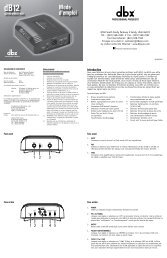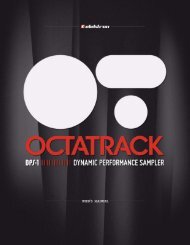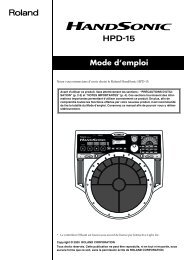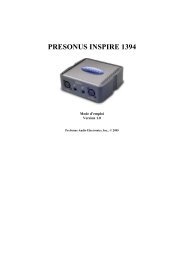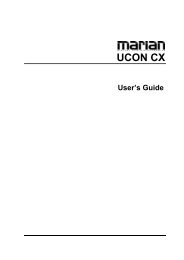1642-VLZ3 16-Channel Mic/Line Mixer Owner's Manual
1642-VLZ3 16-Channel Mic/Line Mixer Owner's Manual
1642-VLZ3 16-Channel Mic/Line Mixer Owner's Manual
You also want an ePaper? Increase the reach of your titles
YUMPU automatically turns print PDFs into web optimized ePapers that Google loves.
MONO PLUG<br />
Direct out with no signal interruption to master.<br />
Insert only to first “click.”<br />
MONO PLUG<br />
<strong>Channel</strong> Insert jack<br />
<strong>Channel</strong> Insert jack<br />
Direct out with signal interruption to master.<br />
Insert all the way in to the second “click.”<br />
STEREO<br />
PLUG<br />
<strong>Channel</strong> Insert jack<br />
For use as an effects loop.<br />
(TIP = SEND to effect, RING = RETURN from effect.)<br />
Figure F<br />
Mackie Stereo Inputs and Returns: Mono,<br />
Stereo, Whatever<br />
A stereo signal, having two plugs, should be patched<br />
into the LEFT (MONO) and the RIGHT input or return<br />
jacks. A jack switch in the RIGHT jack will disable the<br />
mono function, and the signals will show up in stereo.<br />
A mono signal connected to the RIGHT jack will show<br />
up in the right bus only. You probably will only want to<br />
use this sophisticated effect for special occasions.<br />
Mults and “Y”s<br />
A mult or “Y” connector allows you to route one output<br />
to two or more inputs by simply providing parallel wiring<br />
connections. You can make “Y”s and mults for the<br />
outputs of both unbalanced and balanced circuits.<br />
Remember: Only mult or “Y” one output into<br />
several inputs. If you need to combine several<br />
outputs into one input, you must use a mixer,<br />
not a mult or a “Y.”<br />
Owner’s <strong>Manual</strong><br />
Stereo line inputs and stereo returns are a fine<br />
example of the Mackie philosophy (which we just made<br />
up) of Maximum Flexibility with Minimum Headache.<br />
The inputs and returns will automatically be mono or<br />
stereo, depending upon how you use the jacks. Here’s<br />
how it works:<br />
A mono signal should be patched into the input or<br />
return jack labeled Left (MONO). The signal will be<br />
routed to both the left and right sides of the return<br />
circuit, and will show up in the center of the stereo pair<br />
of buses it’s assigned to, or it can be panned with the<br />
PAN control.<br />
RING (IN)<br />
RING (RETURN)<br />
TIP (OUT)<br />
RING<br />
(RETURN)<br />
TIP<br />
(SEND)<br />
FROM<br />
PROCESSOR<br />
OUTPUT<br />
TO MIXER<br />
CHANNEL INSERT<br />
TO<br />
PROCESSOR<br />
INPUT<br />
TIP (SEND)<br />
Y-cord insert cable<br />
Y-cord splitter cable<br />
Owner’s <strong>Manual</strong><br />
27






